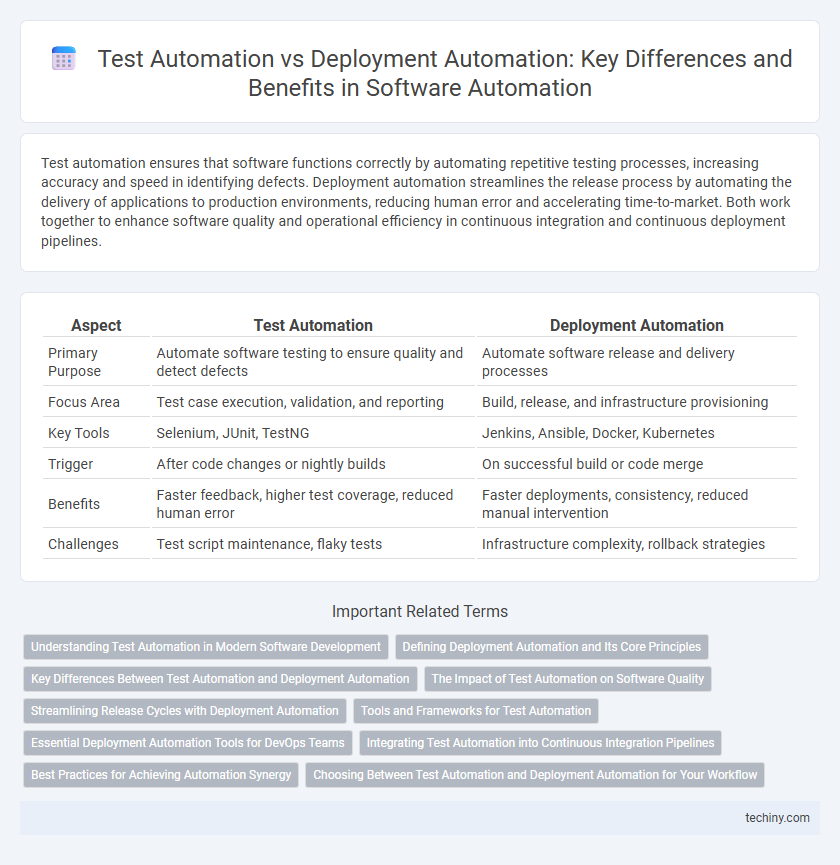Test automation ensures that software functions correctly by automating repetitive testing processes, increasing accuracy and speed in identifying defects. Deployment automation streamlines the release process by automating the delivery of applications to production environments, reducing human error and accelerating time-to-market. Both work together to enhance software quality and operational efficiency in continuous integration and continuous deployment pipelines.
Table of Comparison
| Aspect | Test Automation | Deployment Automation |
|---|---|---|
| Primary Purpose | Automate software testing to ensure quality and detect defects | Automate software release and delivery processes |
| Focus Area | Test case execution, validation, and reporting | Build, release, and infrastructure provisioning |
| Key Tools | Selenium, JUnit, TestNG | Jenkins, Ansible, Docker, Kubernetes |
| Trigger | After code changes or nightly builds | On successful build or code merge |
| Benefits | Faster feedback, higher test coverage, reduced human error | Faster deployments, consistency, reduced manual intervention |
| Challenges | Test script maintenance, flaky tests | Infrastructure complexity, rollback strategies |
Understanding Test Automation in Modern Software Development
Test automation in modern software development focuses on creating reusable scripts and frameworks to consistently validate code functionality, performance, and security throughout the development lifecycle. It enables rapid feedback by automatically executing unit, integration, and regression tests, ensuring code quality and reducing manual testing efforts. Unlike deployment automation, which streamlines software release processes, test automation primarily aims to detect defects early and maintain software reliability at scale.
Defining Deployment Automation and Its Core Principles
Deployment automation involves the use of tools and scripts to automatically release software updates to production environments, ensuring consistent and error-free delivery. Core principles include repeatability, version control integration, environment consistency, and automated rollback capabilities to minimize downtime and deployment risks. This approach streamlines the release process, enhances deployment speed, and maintains system stability across multiple environments.
Key Differences Between Test Automation and Deployment Automation
Test automation focuses on executing predefined test cases to validate software functionality, performance, and reliability, using tools like Selenium and JUnit to detect defects early in development. Deployment automation involves the automated delivery and configuration of software across various environments, leveraging CI/CD pipelines with tools such as Jenkins, Ansible, and Kubernetes for consistent and rapid releases. The key difference lies in test automation ensuring code quality through repeated testing, whereas deployment automation ensures efficient and error-free software release management.
The Impact of Test Automation on Software Quality
Test automation significantly enhances software quality by enabling early defect detection through continuous and comprehensive test coverage, which reduces human error and accelerates feedback loops in the development cycle. Automated test suites validate code changes consistently across diverse environments, ensuring reliability and stability before deployment. This proactive quality assurance approach minimizes production incidents and improves user satisfaction by delivering robust, error-free software.
Streamlining Release Cycles with Deployment Automation
Deployment automation accelerates release cycles by automating the process of delivering applications to production environments, reducing manual errors and ensuring consistency. Unlike test automation, which focuses on verifying software quality, deployment automation streamlines integration, configuration, and delivery, enabling rapid and reliable releases. This efficiency supports continuous delivery practices, minimizes downtime, and enhances overall software deployment speed.
Tools and Frameworks for Test Automation
Test automation relies heavily on frameworks like Selenium, JUnit, and Appium, which provide robust tools for scripting, executing, and reporting tests across various platforms. These tools enable continuous integration pipelines to detect defects early by automating functional, regression, and performance testing. Unlike deployment automation tools such as Jenkins or Ansible that focus on software delivery, test automation frameworks emphasize enhancing test coverage and accuracy through reusable test scripts and detailed test management.
Essential Deployment Automation Tools for DevOps Teams
Essential deployment automation tools for DevOps teams include Jenkins, GitLab CI/CD, and Ansible, which streamline the continuous integration and continuous deployment (CI/CD) pipeline. Kubernetes and Docker facilitate container orchestration and management, enhancing scalability and consistency in application deployment. These tools collectively reduce manual errors and accelerate release cycles, enabling efficient and reliable software delivery.
Integrating Test Automation into Continuous Integration Pipelines
Integrating test automation into continuous integration (CI) pipelines enhances software quality by automatically validating code changes through automated test suites during each build. Test automation focuses on verifying functionality and detecting bugs early, while deployment automation streamlines the release process by automating environment provisioning and application delivery. Seamlessly combining test automation within CI pipelines accelerates feedback loops, reduces manual errors, and supports rapid, reliable software releases.
Best Practices for Achieving Automation Synergy
Test automation ensures code quality and functionality by automating test cases, while deployment automation streamlines release processes through continuous integration and continuous delivery (CI/CD) pipelines. Synchronizing test automation with deployment automation minimizes errors and accelerates software delivery, leveraging tools like Jenkins, Selenium, and Docker for seamless integration. Establishing clear version control, environment consistency, and automated rollback strategies enhances automation synergy, resulting in improved reliability and faster time-to-market.
Choosing Between Test Automation and Deployment Automation for Your Workflow
Test Automation streamlines the process of verifying software functionality through automated scripts, reducing manual errors and accelerating quality assurance cycles. Deployment Automation focuses on automating the release of application updates, ensuring consistent and reliable software delivery to various environments. Selecting between Test Automation and Deployment Automation depends on whether your priority is enhancing software quality control or optimizing continuous integration and delivery pipelines.
Test Automation vs Deployment Automation Infographic

 techiny.com
techiny.com